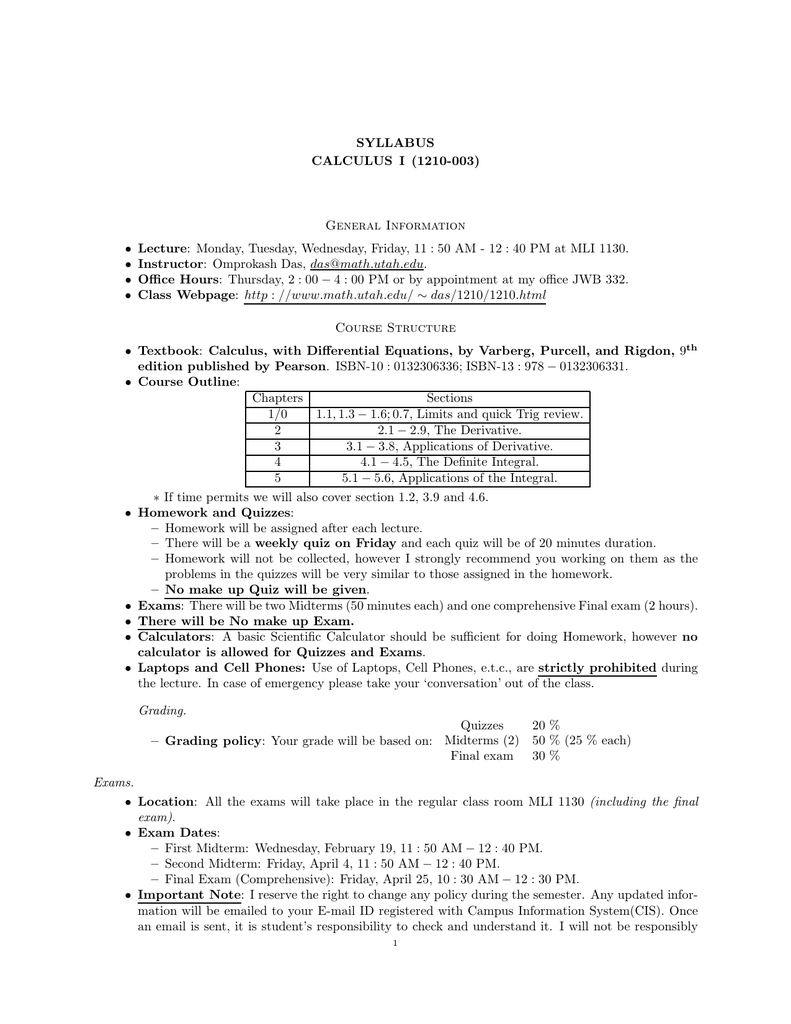Ap Calculus Syllabus Pdf

Welcome to Mathematics E-15: Calculus 1
Syllabus For Ap Calculus Ab
Calculus, Volume 1: One-Variable Calculus, with An Introduction to Linear Algebra. Waltham, Mass: Blaisdell, 1967. 2 will be needed for those who wish to continue on to 18.024 Multivariable calculus with theory.). Calculus BC is a full-year course in the calculus of functions of a single variable. It includes all topics covered in Calculus AB plus additional topics. Both courses represent college-level mathematics for which most colleges grant advanced placement and credit.
| Course Information: personnel, textbook, grading, calculators, extra help, accessibility services | |
| Schedule of Topics: what we'll be learning each week | |
| Schedule of Assignments: when homework is due and when exams take place | |
| Homework Policies: how to submit your homework and not lose points unnecessarily | |
| Exam Policies: how and where to take exams and how to submit proctor information for distance students | |
| Textbook FAQ: answers to textbook-related questions students often ask (and tips to get an inexpensive book) | |
| Prerequisite FAQ: recommended background, the optional placement test, course preparation suggestions | |
| Credit Status FAQ: information to help you choose undergraduate, graduate, or noncredit status | |
| Online-only course FAQ: how we designed this online-only version of Math E-15 specifically for online learners | |
| Questionnaire: please either (1) download this file, fill it in and save it on your own machine, then upload it to Canvas (below) or (2) print it out, write in your answers, and then upload a scan or photo to Canvas. [All questionnaire responses will be kept confidential. The questionnaire is a way for me to get to know you; you are welcome to skip any questions you choose.] | |
| Additional Problems(4th edition, 5th edition, 6th edition): suggested extra problems from the three most recent editions of the recommended textbook | |
| Graduate Credit Information: format, grading, and goals for the seminar for graduate credit students. | |
| Graduate Credit Handouts (print each before watching the video):Day One • Day Two • Day Three • Day Four, the Supplementfor extra reading on limits, the applet we will use to explore the epsilon-delta definition of the limit | |
| Graduate Credit Lessons: Lesson Ideas topics for your lessons, the rubric for the lessons you will present | |
Homework | HW1 • HW2 • HW3 • HW3a • HW4 • HW5 • HW6 • HW7 • HW7a • HW8 • HW9 |
| Week One Content | If you haven't registered and would like a small taste of what this online-only course is like, you can access the Week One videos and interactive applets below. As a registered student, you would also have access to
|
| Zoom | We will be using Zoom for the graduate seminar presentations for distance graduate credit students. Harvard has provided contact informationfor you to get help if you have technical difficulties with Zoom. Eric has written some suggestions on using Zoom including some important notes on presenting your lessons. |
The syllabus page shows a table-oriented view of the course schedule, and the basics ofcourse grading. You can add any other comments, notes, or thoughts you have about the coursestructure, course policies or anything else.
To add some comments, click the 'Edit' link at the top.
Course Summary:
| Date | Details |
|---|
Advanced Placement Calculus AB
Course Syllabus
Donovan, Room 104
Unit | Time | Content | Curricular Requirements |
1 | 2.5 weeks | Limits –investigation of limits through the table feature of the calculator, graphs and analytic methods; definition of limit; limit properties, Squeeze Theorem and its use for finding limits of functions that cannot be found analytically; one-sided limits; infinite limits and vertical asymptotes Continuity – definition and 3-step verification; continuity of composite functions Intermediate Value Theorem and its proof | C2, C3, C5 C3, C4 C2 |
2 | 5-6 weeks | The derivative – limit definition of derivative; using the definition to find derivatives of some of the basic functions; graphical investigation of local linearity extending into the tangent line concept and the slope of a curve at any given point; when derivatives fail to exist – explored graphically and analytically; product and quotient rules; proof of the theorem that differentiability implies continuity; derivatives of all 6 trig functions; higher order derivatives and their application to the position function, velocity, and acceleration functions (the derivative as a rate of change);Chain rule; derivatives of transcendental, logarithmic, and exponential functions; Implicit differentiation, logarithmic differentiation Interpreting graphs – the relation between the graph of a function and the graph of its derivative Derivative of inverse functions, including inverse trig functions Related Rates Newton’s Method of Approximating zeros of a function – derivation of this method | C2, C3, C5 C4 C4 C2 C3, C4 C3 C4, C5 C3,C4, C5 |
3 | 5 weeks | Extrema – graphically and analytically; Extreme Value Theorem and its proof; critical numbers; relative and global extrema Rolle’s Theorem and the Mean Value Theorem – proofs of both Functions – increasing/decreasing; concavity; first and second derivative tests for extrema; second derivative test for points of inflection/concavity Limits at infinity and horizontal asymptotes Curve sketching – applying the above concepts; more investigation/interpretation of the relation between a function’s graph and the graphs of its first and second derivatives, using graphs and tables to make the connections Optimization – applications of the derivative Differentials | C3, C5 C3, C4 C3, C4, C5 C3 C3,C4, C5 C4, C5 C3 |
4 | 5 weeks | Antiderivatives and indefinite integrals – preview only Area (of nonnegative function between the function and the x-axis) using sigma notation; investigation of lower, upper, and midpoint sums, Riemann Sums and the definite integral – formal definition of the integral The Fundamental Theorem of Calculus and its proof; The Mean Value Theorem for Integrals (its proof) and the Average Value of a Function; the Second Fundamental Theorem of Calculus and its proof; Displacement versus total distance Integration techniques: integration by substitution; using the Trapezoidal Rule (when an antiderivative of the given function cannot be found); integration of the natural logarithmic function; integration by parts | C2 C3 C3 C3 C3, C5 C2, C3 |
5 | 2.5-3 weeks | Differential Equations – solved by separation of variables Applications – Exponential Growth and Decay, Newton’s Law of Cooling, etc. Slope Fields | C3, C5 C4, C5 C3, C4 |
6 | 1.5-2 weeks | Area between two curves Volumes of revolution – disc, washer, and shell methods Volumes using cross-section areas perpendicular to one of the axes | C2, C3, C5 C2, C3, C5 C2, C3,C5 |
7 | 2 days | L’Hopital’s Rule for finding limits of functions in indeterminate form | C2 |
Curricular Requirements, as referenced above:
C2 – The course teaches all topics associated with Functions, Graphs, and Limits; Derivatives; and Integrals as delineated in the Calculus AB Topic Outline in the AP Calculus Course Description.
C3 – The course provides students with the opportunity to work with functions represented in a variety of ways - - graphically, numerically, analytically, and verbally - - and emphasizes the connections among these representations.
C4 – The course teaches students how to communicate mathematics and explain solutions to problems both verbally and in written sentences.
C5 – The course teaches students how to use graphing calculators to help solve problems, experiment, interpret results, and support conclusions.
AP Calculus AB
Course Overview: The purpose of the course is to learn and apply various techniques of differentiation and integration. The course presents these concepts from four perspectives: numerical, graphical, algebraic, and verbal.
Required Skills: Students must have completed Trigonometry/Precalculus prior to enrolling in this course and must have a working knowledge of a graphing calculator.
Homework: There are daily assignments. These assignments are checked for completion and process of solution. Most daily assignments will require students to watch a video online. They will be required to join Educreations. Some homework assignments will be collected randomly and graded for correctness on up to 4 problems.
Tests: Most tests have a calculator and a non-calculator portion and are modeled on the free response section of the AP exam. The student is expected to show the set up of the problem and, usually, the solution process. The student must often justify in writing a particular answer.
Quizzes: Quizzes are routinely given throughout the course. Each quiz can consist of multiple-choice questions and/or free response questions.
Calculator: The TI-nSpire CAS graphing calculator is required for AP Calculus AB.

Textbook: Calculus: Early Transcendental Functions, 4th edition
Larson, Hostetler, Edward; Houghton Mifflin, 2003
Resources: Calculus - Graphical, Numerical, Algebraic
Finney, DeMana, Waits, Kennedy; Addison Wesley Longman, Inc. 1999
Multiple Choice and Free-Response Question in Preparation for the
AP Calculus (AB) Examination, 8th edition

David Lederman with assistance of Lin McMullin;
D & S Marketing Systems, Inc., 2003
Preparing for the (AB) AP Calculus Examination

George Best and J. Richard Lux; Venture Publishing, 2006
GRADING POLICY:
A 95-100%
A- 92-94.9%
B+ 89-91.9%
B 86-88.9%
B- 83-85.9%
C+ 80-82.9%
C 77-79.9%
C- 74-76.9%
D+ 71-73.9%
Ap Calculus Syllabus College Board
D 68-70.9%
D- 65-67.9%
Tests 50 %
Quizzes/Writing 20%
Homework/Projects 10%
Exam 20 %
CLASSROOM PROCEDURES AND EXPECTATIONS:
- Students are held accountable for their own learning. Thus, students are expected to be able to explore, explain, support, collaborate, and participate in all classroom activities and learning
- Every student will have a folder which they will use to turn in all work and to receive all work to be done for that day. Work will not be accepted unless it is found in the students’ folder
- Every class will begin with a warm-up/homework check followed by brief homework review and class activities
- Students are expected to be ON TIME. 3 tardies will equal one incomplete homework
- Students are expected to work together with Mrs. Donovan as a facilitator
- Consult the calendar on the school website to determine any assignments which you missed after returning from an absence. The student is responsible to obtain all notes or information missed from their peers or on the portal.
- If additional assistance is needed, it is the students’ responsibility to approach the teacher during free time to request extra help
- If extra time occurs in class, students are expected to use that time to work on math assignments only
- Students are expected to Be Prepared, Be Responsive, and Be Engaged at all times
ABSENCE POLICY:
- Excused absences have as many days as the absence to make up missing work. It is the student’s responsibility to check their folder, the calendar or website, and their peers for any work that they have missed
- If a student has an excused absence on the day of a test, they have 1 week to make up the test before or after school. If there is failure to do so, student will receive a 0 for that test.
- If the absence is due to a school activity, the test or quiz make-up day/time must be arranged before the student leaves for the activity. This appointment must be made by the student with Mrs. Donovan.
- Unexcused absences do not get credit for missed work
CONSEQUENCES: Students who fail to abide by classroom rules and expectations will be subject to the following consequences:
- Change of seat
- Student/teacher conference
- Loss of credit on assignment or test/quiz
- Call home to parent/guardian, and/or detention
- Parent conference
- Referral to administration
The syllabus page shows a table-oriented view of the course schedule, and the basics ofcourse grading. You can add any other comments, notes, or thoughts you have about the coursestructure, course policies or anything else.
To add some comments, click the 'Edit' link at the top.
Course Summary:
| Date | Details |
|---|

